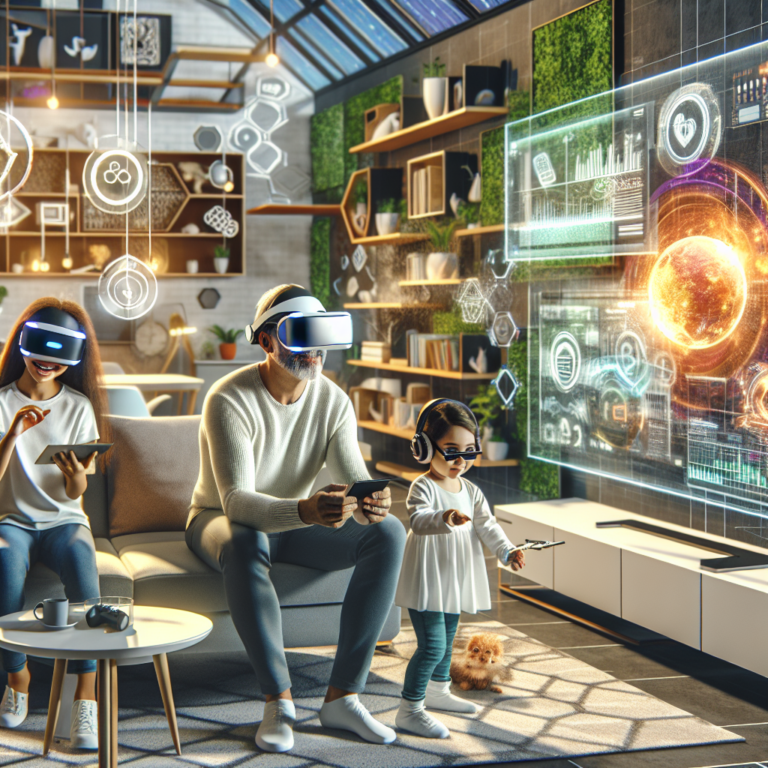Immersive Technology Trends : How Immersive Technologies Are Revolutionizing Consumer Electronics 🎮
A New Era of Innovation
Immersive Technology Trends : The intersection of technology and creativity is witnessing an unprecedented evolution, particularly in the realm of consumer electronics. As immersive technologies such as virtual reality (VR), augmented reality (AR), and mixed reality (MR) become increasingly mainstream, they are reshaping our interactions with devices. This transformation not only revolutionizes how we consume content but also enriches our daily lives in ways we had never imagined. Let’s delve into the exciting landscape where immersive technologies are making waves in consumer electronics.
What Are Immersive Technologies?
Before we explore their impact, it’s crucial to understand what immersive technologies entail. Each offers unique experiences:
- Virtual Reality (VR): Creating a completely simulated environment, allowing users to immerse themselves in a different world through headsets and gloves.
- Augmented Reality (AR): Overlaying digital information onto the real world, enhancing our perception of reality through devices like smartphones and AR glasses.
- Mixed Reality (MR): Combining both physical and virtual elements, enabling users to interact with digital objects in the real world.
The Transformative Effects on Consumer Electronics
1. Gaming Like Never Before 🎮
Immersive Technology Trends : The gaming industry has always been at the forefront of technological advancements, and immersive technologies are pushing its boundaries even further. With VR gaming systems, players can step into their favorite titles, experiencing the thrill of the game as if they are a part of it. Here are some exciting developments:
- Enhanced Experiences: Games designed for VR provide a level of immersion that traditional gaming cannot match, with 360-degree environments and interactive gameplay.
- Social Connections: Multiplayer VR experiences foster a sense of community, allowing players to engage with friends from anywhere in the world.
- Fitness Integration: VR gaming often encourages physical movement, transforming fitness into an engrossing adventure.
2. The Rise of Smart Devices 📱
The integration of AR into smartphones has been a game-changer. Companies like Apple and Google are investing heavily in AR capabilities, allowing users to interact with their environment in innovative ways. Here’s how:
- Seamless Navigation: AR-enabled navigation apps provide live directions overlaid on the real world, making finding new places easier than ever.
- Interactive Shopping: Retailers utilize AR to allow customers to visualize products in their own space before making a purchase, enhancing the online shopping experience.
- Enhanced Photography: AR filters and effects can dramatically transform photos, encouraging creativity and engagement among users.
3. Elevating the Home Entertainment Experience 🍿
As consumers seek more immersive home entertainment experiences, technologies such as 3D audio and VR home theaters are leading the charge.
- 3D Surround Sound: Sound systems are now incorporating immersive audio technology, creating a three-dimensional experience that places listeners in the center of the action.
- VR Movie Viewing: Virtual reality headsets are not just for gaming; they offer users the chance to watch films in a virtual cinema, making for a truly unique viewing experience.
- Interactive Content: Streaming services are exploring VR content, allowing viewers to step inside stories and engage with narratives like never before.
The Art of Design Meets Cutting-Edge Tech 🎨
The aesthetics of consumer electronics are evolving hand-in-hand with immersive technologies. Manufacturers are prioritizing not just functionality but also the overall user experience and visual appeal.
- Sleek Interfaces: Devices are now being designed to offer intuitive AR interfaces that enhance usability and accessibility.
- Personalized Experiences: Customizable settings and features empower users to tailor their interactions, making electronics feel more personal.
- Eco-Friendly Innovation: With sustainability in mind, companies are incorporating eco-friendly materials and practices in producing these immersive devices.
Challenges on the Horizon ⚠️
Despite the promising advancements, the adoption of immersive technologies in consumer electronics is not without its challenges. Some potential hurdles include:
- Cost Barriers: High initial costs can limit consumer accessibility, although prices are gradually decreasing as technology matures.
- Content Creation: Continued investment in developing compelling content is essential for maintaining user interest and expanding the market.
- User Adaptation: Ensuring a smooth transition for consumers unaccustomed to immersive experiences will be key in widespread adoption.
The Future of Immersive Technologies in Consumer Electronics
The evolution of immersive technologies within consumer electronics is just beginning. As these technologies continue to advance, we can expect even more groundbreaking innovations:
- Wearable Experiences: The future will likely see increased integration of AR in wearables, offering hands-free access to information and applications.
- Artificial Intelligence: AI will play a significant role in enhancing the immersive experience by personalizing content and improving interactivity.
- Smart Homes: The proliferation of smart home devices will integrate immersive tech, providing personalized environments tailored to individual preferences.
The dream of a fully immersive digital ecosystem is closer than ever, promising to reshape how we interact with technology in our daily lives. As we embrace these innovations, the possibilities are endless! 🚀




0 Comments